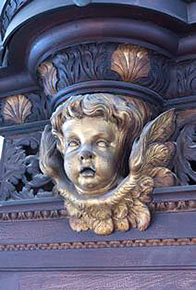Organ: history
The history of the organ
Only four large organs could be found in English churches in the eighteenth century. Those at St. Paul's Cathedral, Salisbury Cathedral and St. Mary Redcliffe, Bristol have long since disappeared – only the organ at Christ Church remains, and almost the only instrument that bears witness to the vibrant and rich musical life of Georgian London.
Bridge's organ, with three rows of keys and over two thousand pipes, was erected on the west gallery of the church in a case of solid mahogany. The double serpentine front, exuberantly carved in the richest taste, is one of only eight ever made to that pattern and of those is by far the largest. The gilded front pipes include the low notes down to contra G, five notes lower than found on organs built today.
Most of the structure of Bridge’s instrument survived the nineteenth century without radical alteration, and although there were some losses towards the end of the century, and further modifications in the 1920s, much of the original pipework, soundboards, action parts, elements of the wind system and the magnificent case, are extant. Sufficient evidence is being gleaned from the careful study of what survives to enable us to reconstruct the missing parts with confidence.
By the 1950s, the organ had been neglected so badly that it was unplayable. The future of the church was also uncertain and at one point threatened with demolition. This led to the campaign to save the building, and over the course of many years, The Friends of Christ Church Spitalfields raised the considerable sums of money needed to achieve this.
Chronology
1735
New organ by Richard Bridge installed
1779
Organ renovated (builder unknown); French Horn and Kettle Drum added
c1811
1½ octaves of pedals added by GP England
1822
Repaired by J C Bishop; Dulciana added and Mixture III from Choir removed
1837
After a fire in the steeple in 1836, H C Lincoln was brought in the following year to
make repairs necessitated by extensive water damage.
In addition, the following changes were made:
French Horn and Vox Humana from Choir removed; Swell extended to tenor c
Double Diapason and Sexquialtra IV added to Swell; German Flute removed
Pedal Pipes GGG – G, 25 notes added
1852
Organ partially reconstructed by Gray & Davison
Pedal Organ acquired three new stops from c 16'; Pedal bellows added
Swell Organ extended to C with revised specification
Some Great stops altered
Some Choir stops altered
New stop knobs
New horizontal double-rise reservoir
c1870
Alterations and additions by TC Lewis
c1899
Alterations and additions by WJ Northcott
1926
Further modifications by Bishop & Son:
New concave and radiating pedals
Electric blower added
Tuba added on pneumatic action
Pneumatic action to pedals
Some further stop changes
1998
Organ dismantled by William Drake and stored for safekeeping during the church restoration.
2012-2015
The restoration of the 1735 Richard Bridge organ, built for Christ Church and a rare eighteenth-century instrument of historical significance, was completed by William Drake Ltd.
2016
Additional work: installation, by William Drake Ltd, of the Quintadena stop in the Choir organ.

‘The presence of an instrument of this quality and importance will more or less of itself guarantee that Christ Church is able to appoint successive organists of exceptional calibre. Moreover, the church would inevitably become a centre for scholarship, learning, and concert use which would attract a large and varied public into this area of London.’
James O’Donnell, Organist and Master of the Choristers, Westminster Abbey
Detail of the unrestored case.
photograph SRB Humphreys

